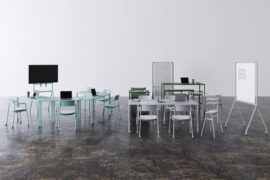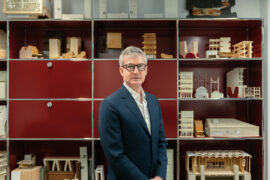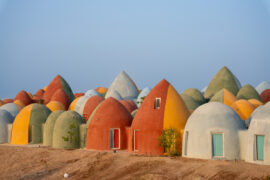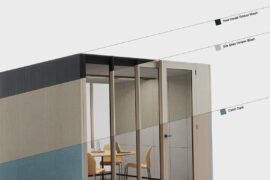Tilt Industrial Design Managing and Creative Director, Tim Phillips, comments on how industrial design intersects with First Nations artists.

May 28th, 2024
Over the past decade, there has been a significant uplift in public art opportunities activated by the implementation of public art policies across the country. As urban spaces evolve, councils are embracing the opportunity to strengthen community identity and create civic legacies through the integration of artwork in the built environment. Increasingly, we are seeing public art investments being funnelled into opportunities for First Nations storytelling, to weave cultural significance into the fabric of our buildings and cities.
The rise of public art generally, and First Nations-led artworks resulting from the NSW Connecting to Country Framework, is a positive step forward for our cities. Public art commissions, however, are often not tailored to delivering artwork alone and they require the contracted artist to administer complex contracts whilst delivering artwork elements to commercial sites, under commercial building terms. Navigating the artistic opportunity and commercial obligations requires a collaborative approach to project delivery, to support the artist and draw on the expertise of a public art project team.
When Tilt began, it was founded on the purpose of supporting creativity in architecture and has now evolved to embrace the creative ambitions of landscape architects and artists. Over recent years, public art has become a significant segment of our client base and half of these projects have been specifically developed with First Nations participation. These projects have provided a platform for cultural learning, and have enabled collaborative and experimental design processes to transform artistic visions into engaging public installations.



Project support and mentorship
Through Tilt’s collaborative approach to design and the application of the industrial design process, we support artists in showcasing their artwork to a mass audience, delivering impactful public art outcomes. At the heart of our process is a genuine curiosity to learn and develop a deep understanding of the artist’s concept and practice. With every step in the design process, the artist is at the forefront of consultation and decision-making to ensure the finished piece accurately reflects their vision.
In these public art projects, our support extends beyond design and fabrication into project management, relieving the artists of the commercial burden of contractual obligations. Importantly, Tilt’s approach provides support and freedom for the artist, allowing them to focus on the creative process of making art.
Public art mentorships have paved the way for rising local artists to be discovered and featured in the public domain. Tapping into emerging artist talent pools provides an expanded curatorial potential, leading to greater diversity in creative expression and helps to galvanise communities. Additionally, providing a mechanism for project investment to remain with local artists can provide financial support to those communities, creating a mutually beneficial cycle.

Listening and close collaboration
Tilt’s role in public art projects centres on supporting artists to deliver their art into the physical form. By listening closely to the artist and learning about their creative process, enables us to carefully develop the design, materials and manufacturing processes that enhance the storytelling opportunity, and ensure the outcome speaks authentically to the artists’ practice.
An artisan approach to art-making and craftsmanship are fundamental to the work of many First Nations artists. At Tilt, our design skillsets are focused largely in the digital realm, and this often results in an exciting meeting point of traditional skills and modern technology. We have worked with First Nations poets and linguists, audio recording artists and scientists, to provide a pathway to embed their artwork into public spaces and create more engaging and experiential outcomes.
At the newly opened ‘Gabrugal Yana’ bushwalk in Western Sydney Parklands, we worked closely with First Nations artists Shay Tobin and Djon Mundine OAM along with other artisans to develop a unique series of artwork installations on trees.
Featuring a combination of artistic applications including carving, painting, handmade ceramics, and cast bronze objects, the installations represent the six seasons of the Dharug calendar and depict the weather, plants and animals that are prevalent during those seasons. Scattered along the bushland trail, the artists’ hand marks are embedded in the artwork trees, weaving First Nations identity and knowledge into nature’s canvas.
From consultation to fabrication, our impartial approach to mediums and methodologies encourages the artists to explore beyond their established experiences and to savour the art-making process, as driven and interpreted by them. This collaborative process also creates a knowledge exchange in supporting the artists through the project delivery and providing an educational opportunity for us to learn First Nations teachings.


A final thought
The opportunity to work with and support a variety of emerging and non-traditional creatives, immerse ourselves in cultural experiences and First Nations knowledge, and the challenge to innovate is what motivates our team.
The role of designers, architects and place-makers in embedding First Nations artwork into our cities is to be the conduit and support the process. With early consultation, continual collaboration and a team-based approach, we can ensure First Nations voices are empowered and their stories are translated authentically into the public realm. We need to be willing to listen and learn, to facilitate creative freedom and support meaningful recognition of First Nations art.
Tilt Industrial Design
tilt-industrialdesign.com
Photography
Western Sydney Parklands and Tilt Industrial Design






INDESIGN is on instagram
Follow @indesignlive
A searchable and comprehensive guide for specifying leading products and their suppliers
Keep up to date with the latest and greatest from our industry BFF's!

Welcomed to the Australian design scene in 2024, Kokuyo is set to redefine collaboration, bringing its unique blend of colour and function to individuals and corporations, designed to be used Any Way!

Gaggenau’s understated appliance fuses a carefully calibrated aesthetic of deliberate subtraction with an intuitive dynamism of culinary fluidity, unveiling a delightfully unrestricted spectrum of high-performing creativity.

For Aidan Mawhinney, the secret ingredient to Living Edge’s success “comes down to people, product and place.” As the brand celebrates a significant 25-year milestone, it’s that commitment to authentic, sustainable design – and the people behind it all – that continues to anchor its legacy.

Leading by design, Erik L’Heureux has recently taken the helm of Monash University’s Department of Architecture, and so a new and exciting journey begins for both L’Heureux and the University.

The independent Master Jury of the 16th Award Cycle (2023-2025) has selected seven winning projects from China to Palestine.
The internet never sleeps! Here's the stuff you might have missed

A new online space offers designers enhanced tools, resources and real-time customisation.

The independent Master Jury of the 16th Award Cycle (2023-2025) has selected seven winning projects from China to Palestine.